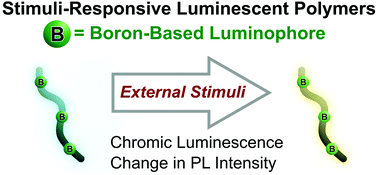Recent developments in stimuli-responsive luminescent polymers composed of boron compounds
Abstract
Stimuli-responsive luminescent materials have received much attention as next-generation smart materials for various applications, including their use as biomedical probes, for the visualization of pollutants and sensing toxic gases. Boron-containing luminophores have been widely utilized to achieve such sensing materials because of their vacant 2pz orbital, which is responsible for their Lewis acidity, electron-accepting properties, and ability to form complexes. In addition, polymeric structures often enhance stimuli-responsivity because slight environmental changes around the molecules can dramatically affect their molecular motions, shapes and physical properties. This review describes the development of stimuli-responsive materials using various kinds of luminescent boron compounds, focusing on the mechanisms of the sensing abilities and the molecular designs.



 Please wait while we load your content...
Please wait while we load your content...